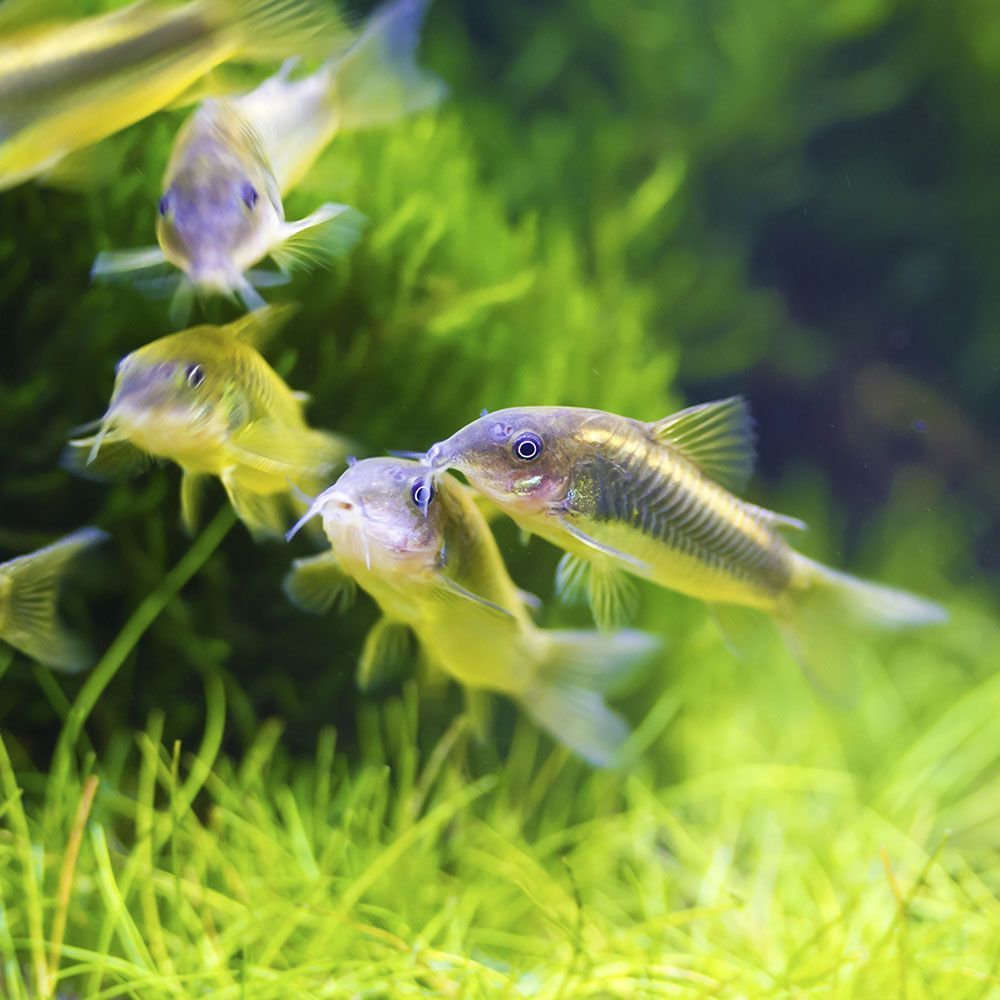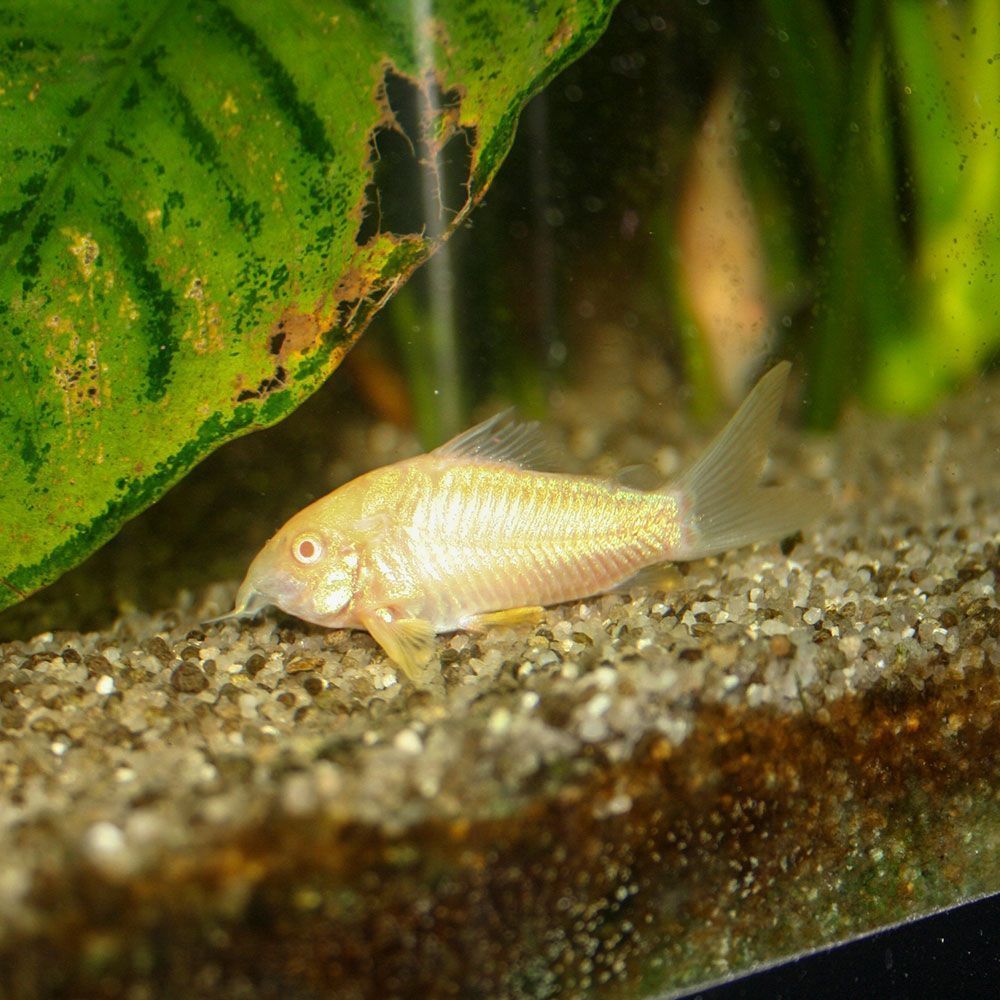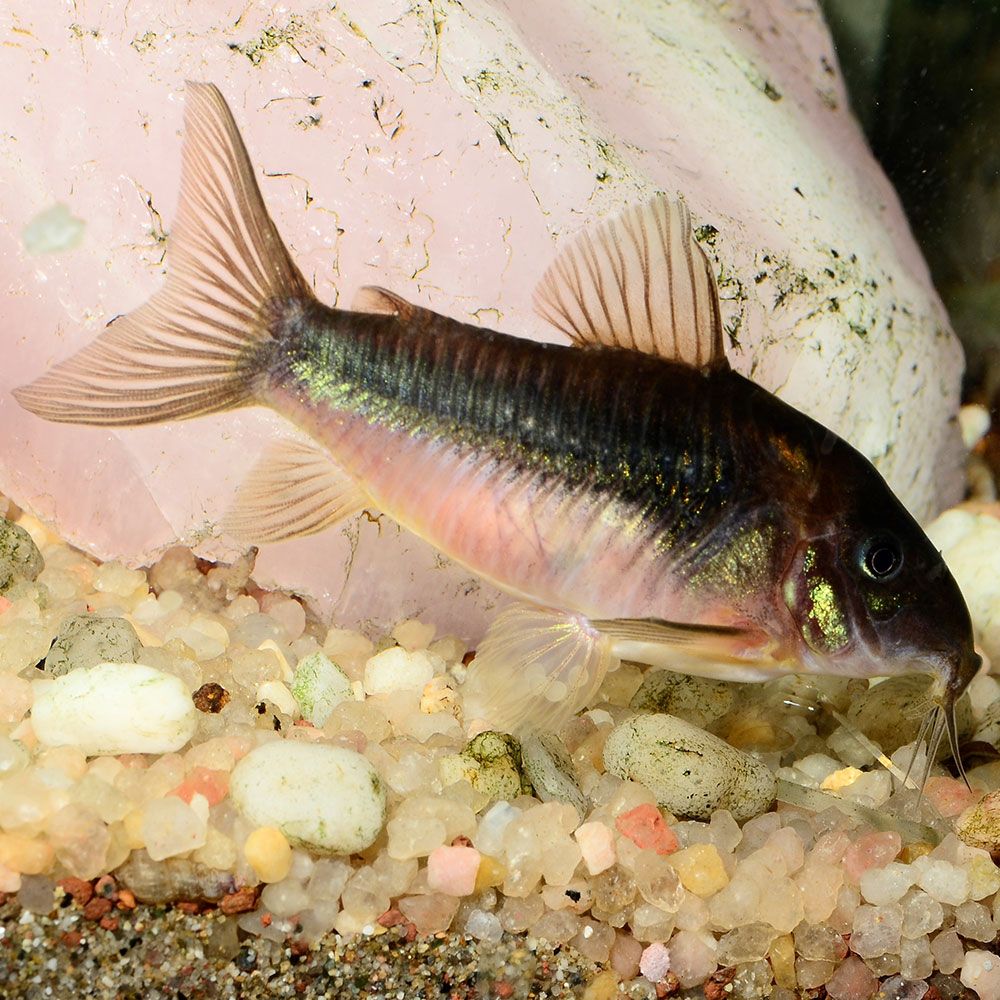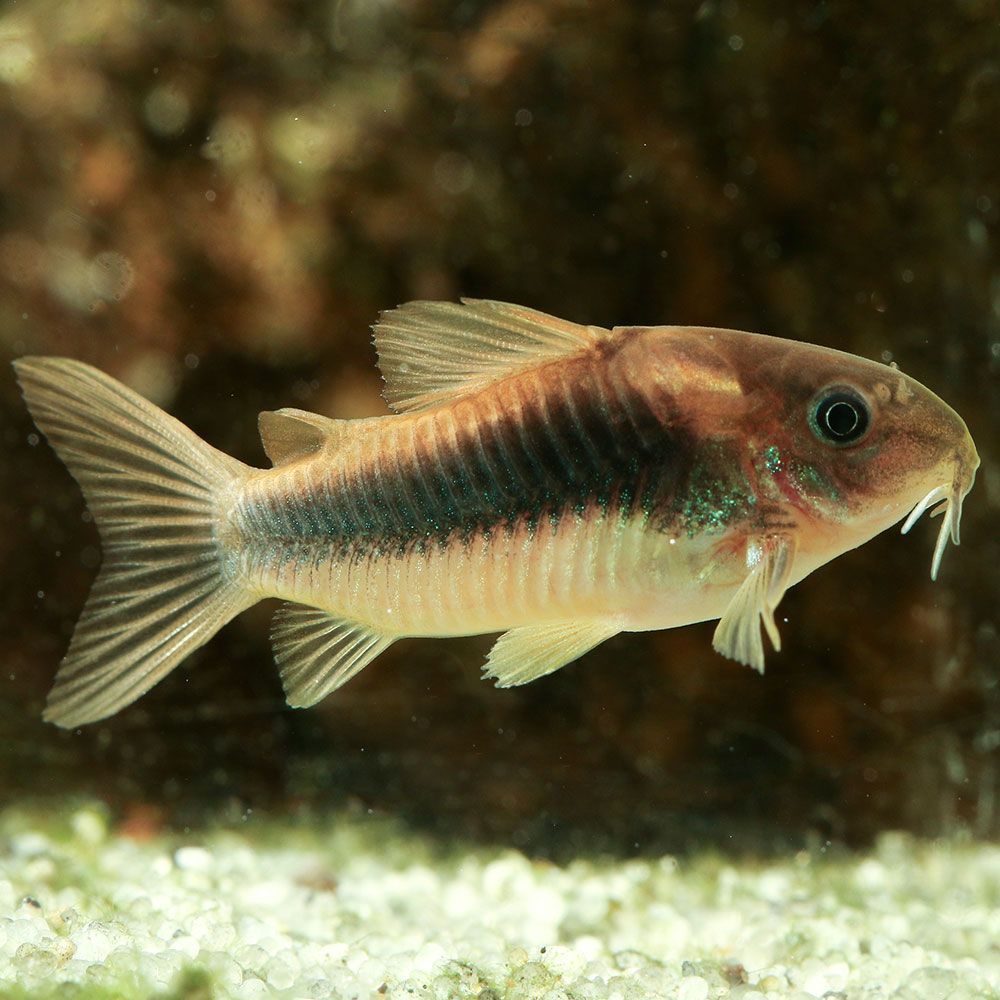The bronze corydoras is one of the most fascinating freshwater fish. It is an excellent addition to any nano and community tanks. Beginners love it for being low maintenance and accepting all kinds of food!
It also disturbs the substrate, making the debris float which, in turn, reminds amateur aquarists to clean the tank.
If you want to bring this aquatic friend home, read on!
What is Bronze Corydoras Catfish?
A bronze Corydoras is a type of catfish that lives in freshwater. Its iw a wonderful fish for the beginners to keep in a tank due to its low maintenance features. Below is some detailed information about this fish:
| Origin | Eastern Andes, from Colombia and Trinidad to La Plata River basin, South America |
| Order | Siluriformes |
| Family | Callichthyidae |
| Scientific Name | Corydoras aeneus |
| Common Names | Bronze corydoras, green corydoras, lightspot corydoras, wavy catfish, or bronze catfish |
| IUCN Red List Status | Least Concern |
| Appearance | Yellow or pink body and fins, bluish grey head and back, green upper side |
| Size | Up to 6.5 cm (2.56 in) |
| Lifespan | Up to 10 years |
| Temperament | Peaceful |
| Tank Level | Bottom dwellers |
| Water Temperature | 72-82 °F (22-28 °C) |
| pH Level | 6.0-7.5 |
| Water Hardness | 5-19 dGH |
| Care Level | Very easy |
| Minimum Tank Size | 30 gallons for about 6 more of them |
| Tank Environment | Vegatation-rich tank with plenty of swimming and hiding spaces |
| Diet | Omnivorous with scavenging habits |
| Tank Mates | 6-8 same species (conspecifics), other peaceful and similar-sized species |
What is the Natural Habitat of Bronze Corydoras Catfish?
The most common natural habitat of this fish is in wide areas of South America. However, in detail, it’s found in the Amazon and Negro River basins, in the La Plata River, Branco River, and Yaracuy River in the following nations:
- Argentina
- Brazil (Acre, São Paulo, Mato Grosso, Mato Grosso do Sul, Maranhão, Pará, Paraná, Rio Grande do Sul, Rondônia, Goiás, Espírito Santo)
- Bolivia
- Colombia
- French Guiana
- Guyana
- Trinidad and Tobago
- Perou
- Paraguay
- Suriname
- Venezuela
- Hawaii islands
In these areas, they mainly prevail in quiet, soft-bottomed shallow waters and even in running water.
It is mainly found in waters with temperatures of 77-82 °F (25-28 °C), pH 6.0-8.0, and 5-19 dGH water hardness.
Since it is a schooling fish, it swims around in the wild in groups of 20-30.
The species was assessed by The IUCN Red List of Threatened Species and labeled Least Concern in 2018.
What is the family for Bronze Corydoras Catfish?
The freshwater fish belongs to the order Siluriformes and the family Callichthyidae.
Its scientific name is Corydoras aeneus. Initially, it had other scientific names like Hoplosoma aeneum and Callichthys aeneus.
But commonly, it’s known by a wide range of names like bronze corydoras, lightspot corydoras, green corydoras, wavy catfish, and bronze catfish.
Fun Fact: If any tank mate tries to pick a fight with your brown cory, it’s well-equipped for self-defense. It stings its attacker with sharp barbs. Its fin also has a leading spine, so tank mates can’t swallow it easily.
How do Bronze Corydoras Catfish look?

Bronze Corydoras Catfish often looks plain from afar, but it’s full of interesting details.
What is the Size of Bronze Corydoras Catfish?
The standard length of the male fish is about 6.0 cm (2.4 in), and that of the female fish is about 6.5 cm (2.6 in).
What is the Color of Bronze Corydoras Catfish?
The body and fins of the fish seem yellow to pink. The head and back of the fish is bluish-grey, and its belly is white.
There’s a brownish-orange patch on its head, right behind the dorsal fin. The upper side of the fish is green, which leads to its name, green corydoras.
This species is also available in the albino, green, and black varieties.
What are the Features of Bronze Corydoras Catfish?
The fish has a rounded and short snout, prominent fins, and overlapping bony plates. Its pectoral spine is internally denticulated. It also has:
- Total dorsal spine: 1
- Total dorsal soft rays: 7
- Anal spines: 1-2
- Anal soft rays: 5-6
- Dorsal plates: 23-24
- Ventral plates: 20-22
- Pre-adipose plates: 2-5
Its fins (dorsal, pectoral, and adipose) have sharp and mildly poisonous barbs.
What is the difference between a male and a female Bronze Corydoras Catfish?
The male fish is slimmer and shorter, and the female fish is rounder, especially around the belly, and longer. This difference becomes more pronounced when the fish carries eggs.
How do Bronze Corydoras Catfish Behave in the Tank?
It is a peaceful fish and prefers to live in shoals (groups of its own species). It doesn’t mind if any fish intrudes on its area.
Albino Cory Catfish

Bronze cory catfish also has another color morph which is popular as albino cory. It is the result of a genetic mutation. It is not found in the wild.
The albino gene is recessive, so it can be created only if both parents are albinos. One albino parent alone can’t procreate another albino catfish.
The fish has a white to pink to orange color body and red eyes. Compared to the common bronze ones, albino fry is known to develop much more slowly.
The species is non-aggressive, peaceful, and expressive, much like the generally found colored one.
In the aquarium culture, many assume a myth that “the albino cory catfish is blind.” Here are some good reasons behind the assumption:
- It often bumps into other objects and fish
- It swims clumsily
- Some believe “albinism” and “blindness” are synonymous
- Often albino varieties of many animals are blind
The truth is, the fish isn’t blind, but its eyes lack pigmentation, and this causes it to have limited eyesight, resulting in vision problems.
It depends significantly on its sense of smell which leads to bumping into things while seeking food. And it’s just not interested in its surroundings while looking for food.
The fish might sometimes be born blind due to excessive inbreeding. But inbreeding also results in sterility.
On the other hand, this morph is also extremely sensitive to white and bright light. So, if you get this pet fish, you must use the dimmest light in your tank.
If you suspect a seller sold you a blind albino cory, shine a light around it. Move the light around and see if the fish reacts to it. If it doesn’t, shine it on its body for 1-2 seconds. If it still doesn’t respond even the slightest, there’s a high possibility of blindness.
What is the Lifespan of Bronze Corydoras Catfish?
This species can live up to 10 years at most. However, most only last till 5 or 8 years. But according to my experience, only meticulous aquarists have sustained them longer than 10 years.
Author’s Note: The fish has sharp pectoral fins that can cut you, so avoid direct contact. Always handle them with containers. Don’t use nets, as the fish may get tangled.
How to take care of Bronze Corydoras Catfish?

If you’re wondering how to sustain your fish to its longest lifespan, here are a few things to remember.
What is the Tank Size for Bronze Corydoras Catfish?
Since it is a shoaling fish, you need to house at least 6 to 8 of them together in a 30-gallon tank (minimum).
However, if you keep more bronze corys or add other tank mates, the tank size must increase considerably.
What is the recommended Water Chemistry for Bronze Corydoras Catfish?
To benefit the longevity of your pet fish, always maintain these water parameters.
- pH Levels: 6.0-7.5
- Water Temperature: 72-82 °F (22-28 °C)
- Water Hardness: 5-19 dGH
- Carbonate Hardness: 0-15 dKH
- Ammonia: 0 ppm
- Nitrite: 0 ppm
- Nitrate: Below 30 ppm
What Tank Environment should be kept for Bronze Corydoras Catfish?
Next, you must focus on creating the perfect environment for it.
Do Bronze Corydoras Catfish need Substrate?
It is better to use the finest quality sand substrate and avoid gravel as it damages their barbels while scavenging.
However, you may use smooth-surfaced gravel. Just remember to clean the gravel of any algae growth regularly. This species isn’t keen on eating algae, and it might make the tank dirty.
Which Plants need to be kept with Bronze Corydoras Catfish?
The fish is timid, so use floating plants to create a cover and make them feel safe. Leafy vegetation is also helpful in sticking their eggs.
What Lighting options should be set for Bronze Corydoras Catfish?
Use moderate to dim lighting to make them feel less exposed.
What Décor should be made for Bronze Corydoras Catfish?
Add caves made of wood or stone as hiding spaces.
What type of filter does a tank with Bronze Corydoras Catfish need?
Use a strong filter of 4-5 times your aquarium volume to keep the environment clean. Change about 20-30% of water monthly.
What is the Water Flow Rate for Bronze Corydoras Catfish?
They enjoy a slow water flow rate.
Fish Care Tip: If leftovers fall from your top-feeding fish, this gluttonous species will consume it. However, that doesn’t mean they can live on that alone.
What food does Bronze Corydoras Catfish eat?
This species can thrive on live food, frozen meaty food, flakes, pellets, and dry food. It also enthusiastically consumes…
- Benthic crustaceans
- Blackworms
- Insects
- Plant matter
- Daphnia
- Brine shrimp
- Bloodworms
- Tubifex
It does not come to the surface during mealtime, so go for sinking feed.
However, if you have top or middle-dwelling tank mates, they may feast on the treats for cory even before it reaches the bottom.
So, place the food on the substrate with tongs and watch whether all corys get a hearty meal.
Make sure they have a varied diet to keep them healthy.
What are the Tank Mates for Bronze Corydoras Catfish?
Before getting tank mates, ensure you have 5-6 bronze corys. You can also add other friendly, social, and schooling fish. Some great tank mates are:
- Small tetras (rummynose tetra, red phantom tetras)
- Small catfish (otocinclus catfish)
- Swordtails
- Zebra danios
- Other corydoras
- German blue rams
- Dwarf cichlids
- Freshwater angelfish
- Peaceful invertebrates of similar size
- Livebearers
Which Tank Mates to Avoid with Bronze Corydoras Catfish?
Never put your bronze corys with aggressive tank mates or those big enough to fit the cory in their mouths. Some unsuitable tank mates are:
- Oscars
- Jack Dempseys
- Texas cichlids
It would be best if you also avoided tankmates that are smaller than it as they can prey on them.
What are the Common Diseases for Bronze Corydoras Catfish?
Though it’s a hardy and disease-resistant fish, your pet cory is not invincible. So, look out for these diseases.
| Disease Name | Causes | Symptoms | Treatment |
|---|---|---|---|
| Columnaris | Bacterial infection | White to grey patches, fin fraying, tiredness, appetite loss | Water quality improvement, stress reduction, antibiotics |
| Fin rot | Bacterial infection | Fin fraying or disintegrating, fin discoloration or red streaks on the fin, tiredness, appetite loss | Improve the water quality, removing all sources of physical injury, antibiotics |
| Ich | Parasitic protozoa | White spotting, flashing, tiredness, appetite loss | Temperature elevation, aquarium salt addition, ich medication |
| Red blotch disease | Bacterial infection, lack of oxygen | Bloody sores on the fish belly, dead white skin, blisters | Medication (Seachem KanaPlex, API furan 2) Prevention: make sure water is rich in oxygen |
| Nitrite poisoning | High nitrite/nitrate levels in water | Faster breathing, sluggish swimming, swimming on aquarium top, lying on tank bottom at the same spot for long periods, not eating | 30% water change, feeding less frequently to reduce unnecessary nitrite production in the tank |
Quick Tip: If you house only one or two bronze cory catfish, they might get depressed from loneliness. It might also lead to lesser activity in the aquarium and minimal feeding. So, house a group to keep diseases at bay.
How to breed Bronze Corydoras Catfish in a tank?
Bronze corys reproduce similarly to most other corydoras. So, follow these steps to induce spawning:
What is the Preparation for the tank for freeding Bronze Corydoras Catfish?
Since corydoras breed during the rainy season, mimic that environment in your tank.
Change 50-70% of the tank water, add cooler water, and lower the pH. You can also use a low-power sprinkler to add water if you face difficulties in spawning.
Keep them on a healthy, high-quality, meaty diet.
How does Courting start for Bronze Corydoras Catfish?
Continue this routine regularly, and the usually shy male fish will start courting the female. The males will rub their barbels and bodies on the female’s body to urge her to mate.
Egg-Depositing Site Preparation
When the female fish is ready to mate, she prepares suitable sites to deposit fertilized eggs.
What is the Mating process for Bronze Corydoras Catfish?
The pair assumes the T-position, where the male’s abdomen connects with the female’s mouth. The male releases his sperm in the female’s mouth. At most, 10 eggs get fertilized at once, and the female deposits the sticky eggs to chosen sites.
She randomly chases her suitors again and continues the same until almost 100-200 eggs get fertilized. The process may even take days.
Development
Remove the adults to another tank. Or, shift the eggs to another tank after 24 hours of deposition.
Keep a thin layer of sand in the tank with eggs. Add methylene blue drops or alder cones to avoid fungus infestation on eggs.
The eggs darken as they develop and hatch after 4-5 days. The incubation phase may vary depending on the tank environment.
After hatching, they feed on their yolk sacs. Once they are free, provide them fry-specific food or minutely chopped infusoria and brine shrimp. Change 10% tank water daily to support fry growth.
Breeding Tip: Make sure you have two males for every female. Since the female produces almost hundreds of eggs, one male isn’t enough to fertilize them all.
What should you consider while buying Bronze Corydoras Catfish?
If you buy the fish in a physical store instead of an online one, do these:
- Avoid buying the fish if you suspect it is dyed, as they are more prone to diseases. Be cautious, especially when getting albino ones.
- Take a close look at the barbels and the belly. Damaged barbels and sunken bellies are signs of malnutrition and health concerns.
A word from FishInAquarium
The bronze corydoras is known to be one of the most expressive and charming fish. Hobbyists swoon over how the fish swims in groups like cute little buds.
If that quenches your thirst, share this with other fish enthusiasts. But if there are more questions, drop us a mail any time. And we’ll get back as soon as possible!


